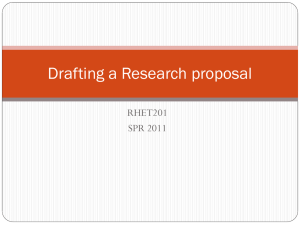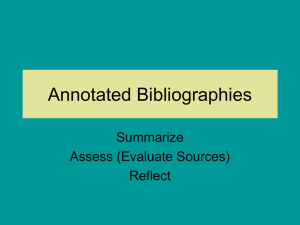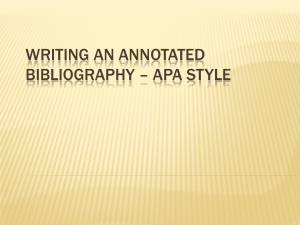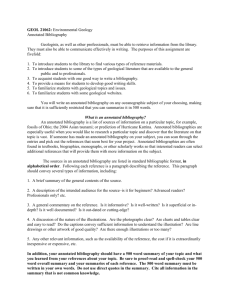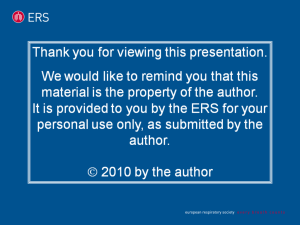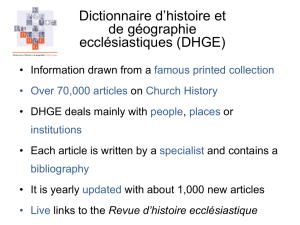Ethical Leadership Annotated Bibliography
advertisement
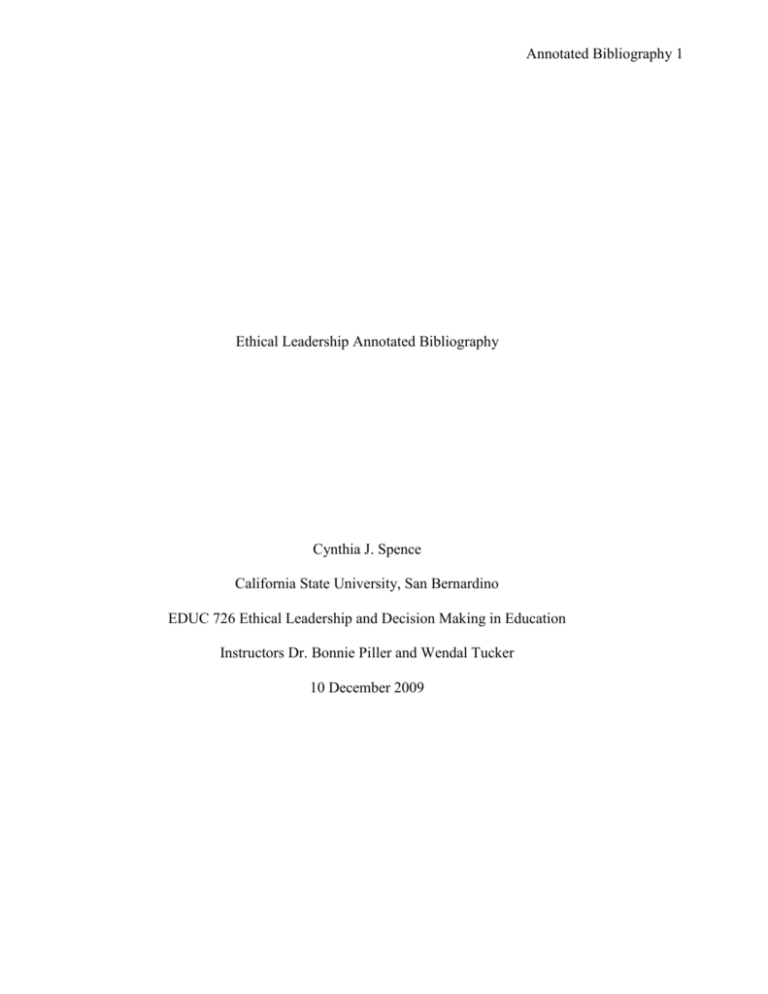
Annotated Bibliography 1 Ethical Leadership Annotated Bibliography Cynthia J. Spence California State University, San Bernardino EDUC 726 Ethical Leadership and Decision Making in Education Instructors Dr. Bonnie Piller and Wendal Tucker 10 December 2009 Annotated Bibliography 2 Barnhart. J. (2008).Beyond being positive. Supervision 69.5, 16-19. In this article, Joe Barnhart, currently the Assistant Director of Information and Telecommunication Services at the University of Montana, emphasizes that good managers need more than a positive attitude to be effective leaders. Barnhart stresses that successful leaders must work to build an environment of trust by honoring employees’ confidences while also creating opportunities for employees to enhance their current work skills, form mentoring relationships, and gain self-confidence through challenging and rewarding projects. While Barnhart’s article offers several important bullet points regarding successful leadership including: time management, conflict resolution, personal physical health, job design, employee evaluations, equity, and emotional stability, Barnhart does not present a specific model to follow nor does he give personal examples demonstrating how a leader can incorporate these suggestions into an often busy and complicated schedule. Although Barnhart works in an educational institution, his article is directed towards organizational leaders who manage employees and can be applied to most working environments. Block, P. (2008). Leadership and the small group. T+D 62.7, 40-43 In this article, Peter Block, the author of several books focused on accountability, stewardship, and empowerment explains the important differences between management and leadership. Block suggests that the role of a manager is to keep things running well the way they currently are. In contrast, true leadership is meant to bring about change. Therefore, management and leadership have two very different functions. In order to be an effective leader, Block promotes creating small groups within an organization in order to build more meaningful relationships. An additional Annotated Bibliography 3 goal of the small group is to promote evocative conversation that empowers and encourages individual employees. Block’s article offers several meaningful quotes that can be used for personal inspiration. However, with the exception of his encouraging the formation of small groups, cautioning leaders to be good listeners, and empowering employees, his article does not offer specific examples of how to implement his suggestions. Connolly, M. the courage of educational leaders. Principal 87.5, 68. In this article, Mike Connolly states that courage is a characteristic those in educational leadership will need just as much as vision, focus, and trust. However, Connolly, an educator himself, feels that many educational professionals feel that they must back away from conflict or public criticism in order to honor their profession. In direct conflict with this opinion, Connolly suggests that school leaders display courage everyday in their interactions with parents, students, and community members who sometimes threaten leaders with both physical violence and character assassination. Connolly encourages educational leaders not to turn away from these negative encounters, but to display true courage by remaining true to their personal beliefs and their professional polices. Connolly’s article brings up the topic of threats and violence which are sadly currently relevant in today’s educational system. By discussing such a difficult and potentially frightening topic, Connolly adds something important to the educational conversation. Engstrom, C. & Tinto, V. (2008). Access without support is not opportunity. Change, Vol. 40 No. 1, 46-50. In this article, Cathy Engstrom, an associate professor at Syracuse University, suggests Annotated Bibliography 4 that there is a direct coloration between economic status and the need for remedial education. Engstrom is concerned that those in educational leadership positions may view remedial students as outsiders and instead of including these students in the educational system they are placed in “marginal” or “add-on” programs that keep these students on the outside edge of higher education where they are more likely to fail. Offering statistical information to validate her argument, Engstrom suggests creating specialized “learning communities” in order to support an already disadvantaged academic population. After receiving a grant from the Lumina Foundation for Education and additional support from the William and Flora Hewlett Foundation, Engstrom carries out a systematic, multi-institutional, longitudinal four-year study of the impact of learning communities. Engstrom’s study concludes that academically under-prepared students were significantly more engaged in the educational process as members of a learning community. According to Engstrom, these “learning community” students reported high levels of support from their college, teachers, and peers which Engstrom feels directly impacted their success. Therefore, it is essential that educational leaders look for programs that promote inclusions vs. exclusion. Engstrom’s article offers strong support for her inclusion argument. Friedman, S.D. (2008). Be a better leader, have a richer life. Harvard Business Review (April), 112-118. In this article, Stewart D. Friedman, a Professor of Management at the University of Pennsylvania’s Wharton School, discusses how to “integrate” rather than “balance” work, home, community, and self (mind, body, and spirit). Friedman believes that trying to achieve balance in life requires constant addition and subtraction adjustments Annotated Bibliography 5 and often important areas are slighted in the process. In contrast, integration allows an individual to blend areas of their life allowing for equal distribution. Friedman suggests that people in leadership positions, try small integration experiments such as having family members join in community outreach projects. By blending family and community, both life areas are fulfilled. Friedman’s concept relies on three principles: being real, being whole, and being innovative. First, an individual must clarify what is important and then they must try various methods of blending the important elements of their life together. Friedman’s article is directed towards leadership professionals and offers specific examples and suggestions for implementing his suggestions. Froschheiser, L. (2008). Unlock the power and potential of your team: 5 secrets to empower your people and become a better leader. Supervision 69.6, 12-13. In this article, Lee Froschheiser, the president of a national business consulting firm, offers five suggestions to becoming an effective leader: Find an accountability coach, become an empowering leader, establish and maintain fundamental business practices, focus on the company’s vital factors, and create passion within your people. Froschheiser encourages leaders to empower employees by giving them more control over the projects they are working on and to resist the temptation to “super-manage” or do the employee’s job for them. Froschheiser believes that by empowering employees leaders really empower themselves. Froschheiser’s article is directed towards anyone who manages employees and while he offers several simple tips such as: giving employees daily feedback, monitoring the health of the company, and defining the company’s mission, vision, values, and goals, the article is light on actual examples explaining how to do these things. This article is similar to Barnhart’s in that Annotated Bibliography 6 its main focus is on building employee confidence and ability. Glanz, J. (2008). Five essential virtues for leading ethically. Principal Leadership 8.9, 64-66. Similar to Connolly’s article, Jeffrey Glanz writes about the importance of being a courageous leader. Glanz currently holds the Raine and Stanley Silverstein Chair in Professional Ethics and Values in the Azrieli Graduate School of Jewish Education at Yeshiva University in New York City. Glanz was also the dean of Graduate Studies and chair of the Education Department at Wagner College in New York City. Glanz directs his article toward principals and offers five virtues for leading ethically: exhibiting courage, maintaining impartiality, demonstrating empathy, judging ethically, and remaining humble. Although this is a relatively short article, Glanz offers several current scenarios that challenge principals in the area of ethics such as unfair tracking placements and favoritism towards students whose parents have money or social influence. Glanz encourages principals to spend time reflecting on the five virtues and then rethink and refocus their goals and efforts accordingly. Hansen, D.T. (2007).Ethical visions of education: Philosophies in Practice New York: Teachers College Press. In this book, David T. Hansen, a Professor and Director of the program in Philosophy and Education at Teachers College, Columbus University, New York, organizes a series of essays that offer a foundational perspective on the aims of education, a political perspective on education, and an ethical perspective on education. When speaking of the authors included in this book, Hansen shares that these are educators who have “responded, rather than simply reacted, to the pressures they encountered” (ix). A few of the philosophers and educators represented are: John Dewey, Paulo Annotated Bibliography 7 Freire, W.E.B. Du Bois, Jane Addams, Tao Xingzhi, and Maria Montessori. Hansen encourages educators to think for themselves and react to their conscience in regards to providing education that is meaningful to students. This book provides an important overview of the ethical struggles behind education while also offering encouragement to educators to find their own ethical foundation to base their practice on. Karp. M.M., Calcagno, C, Hughes, K.L., Jeong, D.W. & Bailey, T. (2008). Dual enrollment students in Florida and New York City: Postsecondary outcomes. Community College Research Center, Vol. 37 No. 2, 1-6. In this brief, Melinda Mechur Karp, a Senior Research Associate at the Community College Research Center at Columbia University, discusses the success of dual enrollment programs in encouraging high school graduation and postsecondary achievement. In her article, Karp reports that dual enrollment students (typically academically advanced white students) are more likely than their peers to earn a high school diploma and were also more likely to enroll in college full time. Karp goes on to explain that overall, dual enrollment students tend to be white females with high grade point averages. However, with the success of dual enrollment programs evident, Karp suggests that this type of program should be made available to middle and low academic achievers as well. To prove her point, Karp offers the findings of dual enrollment programs currently offered in Florida and New York. Both the New York and Florida program report low-income and low-achieving high school students also benefit from participation in dual enrollment programs. Karp’s article supports Engstrom’s position that dual-enrollment programs tend to benefit students of a higher economic status and challenges educational leaders to do the ethical thing and Annotated Bibliography 8 reevaluate and reorganize programs that exclude a large segment of students. Marshall. K. (2008). The big rocks. Principal Leadership 8.7, 16-22 In this article, Kim Marshall, a principal in the Boston schools for 32 years, offers practical advice to principals regarding effective time management. Marshall’s article includes specific and detailed advice such as when to deal with email messages, the importance of writing things down, effective paperwork management, scheduling meetings, interacting with teachers, and taking care of yourself both physically and emotionally. Although Marshall directs his article towards principals his suggestions would prove productive for anyone in leadership. As implicated in the title, Marshall believes that in order to effectively get things done, a leader must first schedule the largest and most important items. Once these items have been identified and scheduled, the next set of items can be effectively included. By focusing on time management strategies, principals can avoid wasting time and will ultimately be better able to meet the needs of their staff and students. Marshall’s article presents many of the ideas mentioned by Block and Froschheiser but in a much more detailed manner. Miles, K.H. (2001). Putting money where it matters. Educational Leadership 59-1, 53-57. In this article, Karen Hawley Miles, the president of Education Resource Management Strategies, suggests that the way schools and districts use their money, organize their staff, and structure their programs needs to change. Miles believes that teachers should be paid according to their education and ability in order to attract the best possible instructors. Miles also believes more money should be spent in the K-3 system, where reading skills are usually acquired, in order to prevent future problems for high school students. Similar to Connolly’s position, that educational leaders must display courage Annotated Bibliography 9 when faced with conflict or public criticism, Miles states that unions, districts, and school board leaders must display courage by making difficult financial choices that may evoke criticism initially but will better serve students and teachers in the long run. Miles directs her article towards educational administrators and is particularly relevant during these difficult financial times when budget concerns are on the forefront of educational conversation. Mills, R. (2006). The Keirsey temperament model: A model for helping educational administrators facilitate ethical decision making. Education 126.3, 512-517. Roxanne Mills begins her article by comparing schools with the business world. Mills stresses that school leaders need to study and apply ethical systems to the school setting in order to guide their institutions effectively because unlike many businesses – schools deal with people rather than a product. Eventually Mills begins to describe the Keirsey temperament model and encourages leaders to examine where they fall in this personality test. The three main personality types are artisan, guardian, and idealist. By understanding how different individuals react to situations, based on their personality, administrators can better predict and guide an individual’s response. Mills’ article seems to have a double focus. The first part of the article discusses ethics and the second half discusses people management. Mills personality approach to being an effective leader seems simplistic. However, treating individuals respectively and being open to their concerns does follow the principles of ethical leadership. Noddings, N. (2006). Educational leaders as caring teachers School of Education 26.4, 339-345. In this article, Nel Noddings, a Lee L. Jacks Professor of Education, Emerita, at Stanford University describes how caring teachers can motivate their students. Annotated Bibliography 10 Noddings encourages teachers to listen to their students and implement responsible experimentation projects in order to improve instruction and learning. Similar to Mills, Noddings points out that schools are dealing with people - not products. Therefore, educators need to design instruction that motivates students to learn rather than programs that simply reward or punish individuals for their output. Noddings believes that different motivational approaches also affect a student’s moral life. For example, students who are coerced or punished may feel inclined to cheat to meet the expected objective. Therefore, teachers should strive to use intrinsic motivation techniques which stimulate a student’s desire to learn rather than focusing on the carrot or the stick approach to teaching. While Noddings’s article is addressed to educational leaders, her focus is on classroom instruction and is geared towards practicing teachers. Palmer, P.J. (2008). On the edge: Have the courage to lead with soul. National Staff Development Council 29.2, 12-16. In this article, Parker J. Palmer, the founder of the Center for Courage & Renewal asks educators to find the courage and the soul to follow their heart when it comes to educating students. Palmer believes the current educational system is leading educators to the brink of violating their ethical obligations to children. Palmer compares the current struggles of educational leaders, staff developers, and “all who care about public education and the students it is meant to serve” (12) to civil rights marchers who faced death and physicians who must strive to do no harm. Palmer believes that true success comes from “relational trust” and collaboration rather than competition. Palmer’s article is very timely at a point when many educational leaders Annotated Bibliography 11 are afraid to confront the current political climate of standardized testing. However, even with the possibility of loosing their position for trying, Palmer believes educators must follow their ethical principles and challenge a system that is doing more harm than good. Nordmann, N. (2001). The marginalization of students with learning disabilities as a function of school philosophy and practice. Journal of Moral Education, 30 (3), 273-286. In this article, Nancy Nordmann, a professor at National-Louis University, Nordmann discusses how students with learning disabilities are being marginalized in the American school system. Nordmann believes “the structure of a school conveys critical information about the structure and functioning of society and engenders the construction of citizens for the society” (274). Consequently, by viewing disabled students as marginal figures, schools can perpetuate the pattern of excluding disabled individuals from mainstream society. In contrast, by welcoming disabled students into the general population, schools can promote an environment of acceptance and acknowledge the positive contributions these individuals make to their communities. Nordmann takes the same position as Karp and Engstrom who challenge educational leaders to make the ethical decision to include rather than exclude students who do not fit the usual model for success. Nordmann’s article effectively communicates the struggles of learning disabled students in our current test centered educational system. Reynolds, B.H. (2008). Inclusion shouldn’t be seen as a threat to school’s learning environment. Principal, 88 (2), 17-19. In this article, Bronte H. Reynolds suggests that administrators are in a particularly strong position to promote diversity and inclusion on their campuses. After Annotated Bibliography 12 establishing that inclusion of disabled students should take place, Reynolds suggests that administrators “get educated, apply the training, grow faculty support, promote parent acceptance, promote understanding by students in the general education classroom, and gather resources” (18-19). Although Reynolds encourages administrators that they do have the ability to set the tone for inclusion, she cautions that true acceptance requires collaboration from all individuals involved. Spring, Joel. (2008). American education. New York: McGraw Hill. In his book, Joel Spring endeavors to explore the numerous educational systems America has created in order to try and insure equal opportunities for its citizens. Spring, a Choctaw Indian, is currently a professor at Queens College and the Graduate Center of the City University of New York. Spring discusses American’s tendency to opt for exclusion over inclusion and the social biases against minorities, females, and disabled students in the American educational system. While segregation may not be technically practiced in America, Spring suggests the unequal dispersion of finances and economic opportunities have created separations that still provide a form of segregation in schools. Spring also discusses the effect of having an international population in the American school system. Issues of identity, language, and culture are raised. One particularly significant question is “Are U.S. teachers prepared for language diversity” (133) and “should the public schools consciously attempt to change or Americanize the culture of immigrant students” (151)? Similar to Karp and Engstrom, Spring challenges educators to examine the ethical issues surrounding exclusion in American schools. Tichy, N.M. & Bennis, W.G. (2007) Making judgment calls: The ultimate act of leadership. Annotated Bibliography 13 Harvard Business Review (October) , 94-102. In this article, Noel M. Tichy, a professor of management and operations and the director of the Global Business Partnership at the University of Michigan and Warren G. Bennis, a university professor at the University of Southern California’s Marshall School of Business, discuss the value of leaders who are able to make successful judgment calls. Tichy and Bennis believe that good judgment is a process that follows a pattern of phases: the preparation phase, the call phase, and the execution phase. The execution phase is particularly important since Tichy and Bennis consider any judgment that is not successfully executed to be a failure no matter how smart the strategy may have been. Tichy and Bennis direct their article to anyone who is in a position to make judgment calls that have an effect on the lives and livelihoods of others. Tichy and Bennis offered detailed suggestions for making good judgments and this article follows many of the “wise leader” definitions included in the learning objectives for CSUSB doctoral program. Wiebe-Berry, R.A. (2008). Novice teachers’ conceptions of fairness in inclusion classrooms. Teaching and Teacher Education, 24, 1149-1159. Ruth A. Wiebe Berry (2008), a professor at the University of New York, approaches the topic of disabled inclusion through the lens of fairness. Berry puts forward that “The concept of fairness is valued in our democratic society, and as a result, in our schools. ‘fairness’ has been defined as the belief that ‘it is morally wrong, in itself, to treat individuals differently without providing relevant reasons for so doing’” (1150). Unfortunately, separating disabled students from the general student population can establish a pattern of treating disabled students “differently” and research suggests that Annotated Bibliography 14 there may be no “relevant” reason for doing so. In fact, Evans proposes that special education is actually “segregated education under the banner of ‘special needs’” (35). Similar to Karp, Engstrom, and Spring, Wiebe-Berry challenges educators to examine the ethical issues surrounding exclusion in American schools. Woods, P.A. (2006). A democracy of all learners: Ethical rationality and the affective roots of democratic leadership School Leadership and Management, 26.4, 321-337. In this article, Philip Woods, a Professor of Leadership and Educational Management in the School of Education, at the University of Aberdden discusses democracy in education. Similar to Hansen and Spring, Woods offers important background information on the development of education under a democratic system of government. According to Woods, this culture of education was meant to “encompass a shared vision and values orientated towards democratic ideals and practice” (331). Woods suggests that a school culture that “takes seriously the implications of developmental democracy profoundly challenges those in senior leadership positions” (332). In his conclusion, Woods challenges educational leaders to be more than a servant of bureaucracy and instead work toward reentering school culture to encompass a shared vision and values orientated towards democratic ideals. Woods article is appropriate at a time when bureaucracy in education seems to be the dominate theme in American schools.
